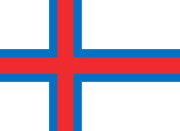Flag of the Faroe Islands


The flag of the Faroe Islands is an offset cross, following as with other Nordic flags the tradition set by Dannebrog. The flag is called Merkið which means "the banner" or "the mark". It resembles the flags of neighbouring Norway and Iceland.
The flag was devised in 1919 by Jens Oliver Lisberg and others while they were studying in Copenhagen. The first time the Merkið was raised in the Faroe Islands was on June 22 that year in Famjin on the occasion of a wedding. On 25 April 1940 the British occupation government approved the flag for use by Faroese vessels. April 25 is still celebrated as Flaggdagur. With the Home Rule Act of 23 March 1948, the flag was finally recognized by the Danish Government as the national flag of the Faroes. The original copy of the flag is displayed in the church of Famjin.
Notably, the flag design lies contrary to the heraldry and vexillology rule that red colour cannot be placed adjacent to blue.
Popular Culture
In the music video for singer Björk's song Declare Independence, the flag of the Faroe Islands (as well as that of Greenland's) are featured on the uniforms of those who appear in the video. Bjork, who is from the former Danish possession of Iceland, has utilized her song as a wake-up call for colonized peoples to break their ties with their colonizers.
See also
- Nordic Cross Flag
References
- Faroe Islands at Flags of the World
|
|||||||||||
|
||||||||